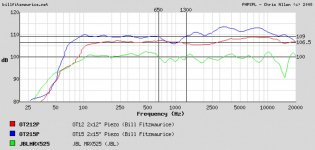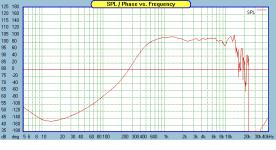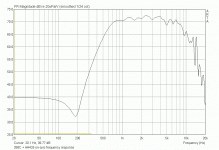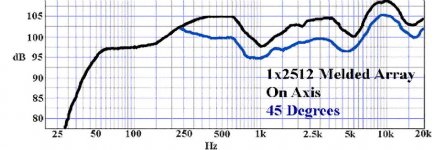BTW - thanks very much Lynn, for your great explanation of the phenomenon, or parts of it. I was beginning to believe I' have to resort to the tired old "If you haven't heard it....." I was really surprised that some folks here had not heard it.
Just as you describe with phono stages and DAC analog stages, if the rest of the chain is also up to the task, wonderful things start to happen. "Magic" is just a fun way of describing it. It isn't magic, just very good (over) engineering. But it can be surprising enough the first few times you hear it to seem like magic. Surprising at first because because you've never heard a system do that. But it starts to make sense had sound quite natural very fast.
Maybe this little side discussion will help point some DIY folks down a path they didn't know existed.
A very good example of what I was talking about.
Just as you describe with phono stages and DAC analog stages, if the rest of the chain is also up to the task, wonderful things start to happen. "Magic" is just a fun way of describing it. It isn't magic, just very good (over) engineering. But it can be surprising enough the first few times you hear it to seem like magic. Surprising at first because because you've never heard a system do that. But it starts to make sense had sound quite natural very fast.
Maybe this little side discussion will help point some DIY folks down a path they didn't know existed.
With the better riaa, the noise from badly handled LP's seemed out of phase and totally disconnected from the music. Cheaper riaa, the noise was right in your face.
A very good example of what I was talking about.

That's a tough question.Dr. Geddes,
What's your Pioneer's model number?
Wouldn't it make more sense to ask Earl why this receiver is so good and what application fits best? What were the parameters he measured and why are they important?
Best, Markus
Markus
Asking questions like that might make one sound like 1) they actually care and 2) that they don't already know the answer.
But here is the answer anyway!
In very high efficiency loudspeaker one is very often at extremely low signal levels within the amps circuitry. This makes a very insidious type of nonlinearity called crossover distortion (where the signal does not go smoothly through zero because the upper and lower sections of the amp are not well aligned) very problematic (audible). Typical measurements of THD versus level won't show this type of distortion at all. They will show high level nonlinearities, but for a high efficiency loudspeaker these signal levels mean very high SPL and very low perception of nonlinearity. Bottom line they aren't a problem. In a typical THD versus level chart the low level measurement is all noise - completely masks the effect of interest. One has to measure the nonlinearity of the signal well down into the noise floor. This can be done, but its not a standard measurement. There was a thread that Migeo posted above that describes the technique and shows some results.
Google is stumped. Maybe VSX-V912?
Yes, my typo.
Man, that was a quick one. We somehow switched from CD player to Amp. I'm getting too slow for this.Google is stumped. Maybe VSX-V912?
Just out of curious, I found a manual of a (maybe) similar series model here:
http://www.scribd.com/doc/299744/Pioneer-Elite-VSX9492TX-owners-manual
(I can't find the exact model. Their model numbers are changing fast.... )
A big WOW! I've been away from such AV equipment for quite a while, now they are so sophisticated! I almost fainted when seeing the rear panel. Is that a honeycomb or multiple rocket launcher? Another bigger WOW is that built-in "phase correction function" !! (see p11 in that manual)
Wow .... speechless....
http://www.scribd.com/doc/299744/Pioneer-Elite-VSX9492TX-owners-manual
(I can't find the exact model. Their model numbers are changing fast.... )
A big WOW! I've been away from such AV equipment for quite a while, now they are so sophisticated! I almost fainted when seeing the rear panel. Is that a honeycomb or multiple rocket launcher? Another bigger WOW is that built-in "phase correction function" !! (see p11 in that manual)
Wow .... speechless....
Man, that was a quick one. We somehow switched from CD player to Amp. I'm getting too slow for this.
Actually it was slew limited phono riaa eq to slew limited CD to crossover notch distortion in amps.

and why would that make you yawn?
6xx pages of.....
um....
what was this about again?
We were talking mouth diffraction in crossover mode amplifiers with sufficiently low panel colorations, right?
Just ordered the $99.95 all-projects CD from the Bill Fitzmaurice website. The most likely candidates at present look like a stacked pair of the OmniTop 12, which give very flat (measured) response, 105 dB/metre efficiency, and a moderate size and weight of 22"W, 30"H, and 18"D, and 60 pounds (for two cabinets & 12" Deltalites).
The comments from the builders indicate that the OT12 and OT15 are more tolerant of driver swaps than the DR280, which has to stick exactly to specification - and requires more EQ in the real world of live gigs. If I'm interpreting the build pictures correctly, the small rear chamber of the OT12 is almost completely filled with damping foam, which make it closer to a resistive-vent than a classical big reflex box like an Altec A5, A7, or the eXemplar or Blue Thunder.
The more I thought about it, I just don't want a big beast like an A5 or a full-size Onken in my living room - they are nearly the size of a refrigerator, weigh well over 100 lbs, and need a hand-truck to move from one place to another. Also, it's not trivial to dampen vibrations in a cabinet that size - the bigger the cabinet, the more over-the-top internal cross-bracing and panel damping need to be. The bracing requirements of cabinets with smaller panel areas are not as difficult.
The comments from the builders indicate that the OT12 and OT15 are more tolerant of driver swaps than the DR280, which has to stick exactly to specification - and requires more EQ in the real world of live gigs. If I'm interpreting the build pictures correctly, the small rear chamber of the OT12 is almost completely filled with damping foam, which make it closer to a resistive-vent than a classical big reflex box like an Altec A5, A7, or the eXemplar or Blue Thunder.
The more I thought about it, I just don't want a big beast like an A5 or a full-size Onken in my living room - they are nearly the size of a refrigerator, weigh well over 100 lbs, and need a hand-truck to move from one place to another. Also, it's not trivial to dampen vibrations in a cabinet that size - the bigger the cabinet, the more over-the-top internal cross-bracing and panel damping need to be. The bracing requirements of cabinets with smaller panel areas are not as difficult.
Attachments
Last edited:
When combined with the Altec or GPA 288 large-format driver and AH425 Azurahorn, I think it's reasonable to get a speaker with 105~106 dB/metre efficiency, reasonably flat response from 100 Hz to 12 kHz, and not too much EQ in the crossover. I might also try a 2-stack of OmniTop 15's, just to see how well they work with the 800 Hz crossover of the 288/425 combination.
See you at the RMAF!!!
See you at the RMAF!!!
Attachments
Last edited:
Sorry Lynn,
do you really believe this marketing drawings.
If yes, please let me know, where i can buy piezos, that can do 113dB from 2500 to 10000Hz and 110dB at 15kHz with 2.83V Input.
Here is some real measurement from the BF-Forum.
do you really believe this marketing drawings.
If yes, please let me know, where i can buy piezos, that can do 113dB from 2500 to 10000Hz and 110dB at 15kHz with 2.83V Input.
Here is some real measurement from the BF-Forum.
An externally hosted image should be here but it was not working when we last tested it.
No intention of using the BFM piezos. I've already paid my dues with the 288 and custom design of the AH425, so I'm sticking with that for the 800 Hz to 10 kHz range. I like the sound of the 288, while other drivers don't do as much for me - and I'm trying to avoid heavy EQ if possible.
Here's Bjorn Kolbrek's measurements of the 288's and 425 on the day he got them - note that Bjorn is using vintage Altec 288C's with circumferential phase plugs, so the HF is completely different. People still argue about whether radial (Tangerine) or circumferential (traditional) phase plugs are better, some 30 years after Altec introduced them. For that matter, the Tangerine is preceded by an older Western Electric radial phase plug that dated to the mid-Thirties.
Here's Bjorn Kolbrek's measurements of the 288's and 425 on the day he got them - note that Bjorn is using vintage Altec 288C's with circumferential phase plugs, so the HF is completely different. People still argue about whether radial (Tangerine) or circumferential (traditional) phase plugs are better, some 30 years after Altec introduced them. For that matter, the Tangerine is preceded by an older Western Electric radial phase plug that dated to the mid-Thirties.
Attachments
Last edited:
The most likely candidates at present look like a stacked pair of the OmniTop 12, which give very flat (measured) response, 105 dB/metre efficiency, and a moderate size and weight of 22"W, 30"H, and 18"D, and 60 pounds (for two cabinets & 12" Deltalites).
Seems a great solution.... I really hope it will perform well, because I've seen that some builders used BETA 12 drivers with Omnitops. I would definitely try it. The build seems very simple, that's a big plus.
Mr. Olson, what makes you believe these won't suffer from diffraction problems at the throat of the horn?
Last edited:
Hard to tell from the pics at the BFM site, but there seem to be some kind of small inserts to fill in the space between the cone and entrance of the horn - a small phase plug, as it were. Since the piezos have little output below 2 kHz, that part of the spectrum is controlled by Bill's phase-plug and horn-throat design.
I'm guessing that the dip we see in the OmniTop15 between 600 and 900 Hz is due to this kind of thing, although its absence in the OT12 is interesting. Maybe the internal chamber is smaller, pushing the cancellation region above the crossover for the piezo tweeters array.
The bottom of the horn range and the top of the big cone (12 or 15-inch) has always been a troublesome region for high-efficiency speakers. The cone is close to its first breakup mode, and the horn response is starting to depart from the desired pattern (and diaphragm) control. Neither is at its best. Unfortunately, the 1~5 kHz region is also where the ear is at peak acuity for distortion and stored-energy problems.
It's probably a little simple-minded on my part, but the intention of using a large-format compression driver, and a smaller-than-fifteen-inch midbass driver, is to leave a little room for overlap. Small-format compression drivers are typically intended for use above 1.5 kHz, and 12-inch drivers can just squeak above 1.5 kHz (with very well-damped surrounds and cones). 1 kHz is usually the end of the line for 15-inch drivers (with the exception of the AESpeaker TD15M). So by choosing a large-format driver that is designed for use down to 500 Hz, I get a little wiggle room in the crossover design - not much, but some.
There is an alternative, a horn-loaded cone midrange. Yes, I'm aware of that - something I might try in the future, but for now, I'll see how the BFM's perform in the 100 Hz to 1 kHz range. I've read just about every comment in the BFM forum, and it appears like the OT12 needs the least EQ of any of them.
For the directivity police, the AH425 is still maintaining pattern control down to 700 Hz, and the controlled dispersion of the OT12 is intended to avoid the beaming of a typical 4x12 array. LF and HF drivers would be in the horn region at crossover, unlike a horn+direct radiator combination.
I'm guessing that the dip we see in the OmniTop15 between 600 and 900 Hz is due to this kind of thing, although its absence in the OT12 is interesting. Maybe the internal chamber is smaller, pushing the cancellation region above the crossover for the piezo tweeters array.
The bottom of the horn range and the top of the big cone (12 or 15-inch) has always been a troublesome region for high-efficiency speakers. The cone is close to its first breakup mode, and the horn response is starting to depart from the desired pattern (and diaphragm) control. Neither is at its best. Unfortunately, the 1~5 kHz region is also where the ear is at peak acuity for distortion and stored-energy problems.
It's probably a little simple-minded on my part, but the intention of using a large-format compression driver, and a smaller-than-fifteen-inch midbass driver, is to leave a little room for overlap. Small-format compression drivers are typically intended for use above 1.5 kHz, and 12-inch drivers can just squeak above 1.5 kHz (with very well-damped surrounds and cones). 1 kHz is usually the end of the line for 15-inch drivers (with the exception of the AESpeaker TD15M). So by choosing a large-format driver that is designed for use down to 500 Hz, I get a little wiggle room in the crossover design - not much, but some.
There is an alternative, a horn-loaded cone midrange. Yes, I'm aware of that - something I might try in the future, but for now, I'll see how the BFM's perform in the 100 Hz to 1 kHz range. I've read just about every comment in the BFM forum, and it appears like the OT12 needs the least EQ of any of them.
For the directivity police, the AH425 is still maintaining pattern control down to 700 Hz, and the controlled dispersion of the OT12 is intended to avoid the beaming of a typical 4x12 array. LF and HF drivers would be in the horn region at crossover, unlike a horn+direct radiator combination.
Last edited:
I know.No intention of using the BFM piezos.
But it seems that you didn't understand the intention of my question. Piezos (even many of them) can not do this.
And now think about the plausability of the rest of this "measurement"
Do you think the BFM measurements are fictitious? BFM is unusual in publishing anything at all. The measurements of the Jack12 look smoothed, but real enough. On the other hand, I've measured Fostex drivers with MLSSA, and found no correlation at all between what I measured and the factory curves.
I should add that the (unpublished) measurements of Klipschorns, LaScala's, Lowther's, and other well-known folded horns are actually worse, with 10~15 dB peak-to-dip ratios. That's what I'm trying to avoid.
I should add that the (unpublished) measurements of Klipschorns, LaScala's, Lowther's, and other well-known folded horns are actually worse, with 10~15 dB peak-to-dip ratios. That's what I'm trying to avoid.
Attachments
Last edited:
- Home
- Loudspeakers
- Multi-Way
- Beyond the Ariel



